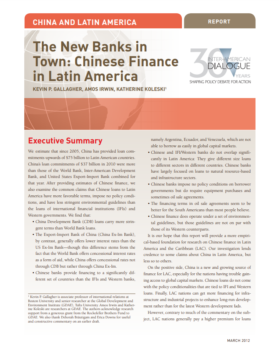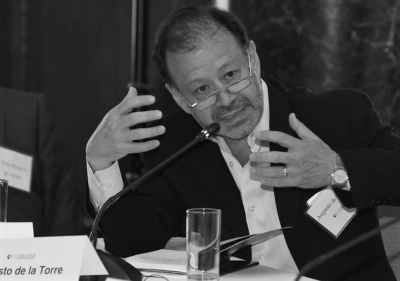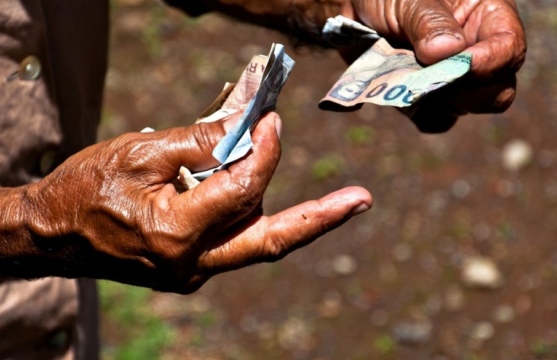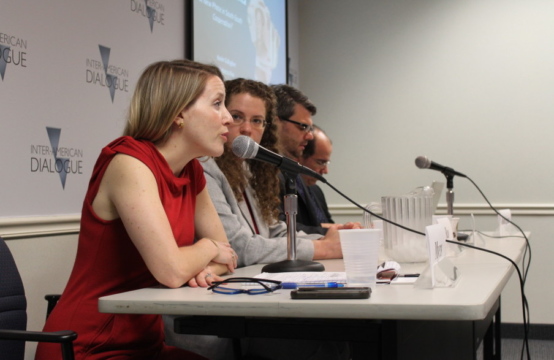
The New Banks in Town: Chinese Finance in Latin America
Estimates of the volume, composition, and characteristics of Chinese lending to the region since 2005.
This publication is part of Asia-LAC Dialogues, a series of interviews produced by the Inter-American Dialogue’s Asia and Latin America Program, featuring global perspectives on recent developments in the Asia-Latin America and Caribbean dynamic.
As first reported by The Wall Street Journal, Ecuador and China reached an agreement this week to restructure $4.4 billion of Ecuador’s debt with Chinese banks, which is estimated to provide $1.4 billion worth of debt relief to Ecuador through 2025. Before these negotiations, Ecuador owed China over $5 billion, according to Foreign Minister Juan Carlos Holguin, with the bulk of that due over the next three years.
Deals were reached directly with China’s policy banks, China Development Bank (CDB) and the Export-Import Bank of China (Eximbank), which together provided over $18 billion in loans to Ecuador since 2010, according to the China-Latin America Finance Database, which is co-produced by the Inter-American Dialogue and the Boston University Global Development Policy Center.
Through a series of measures, including maturities extensions and interest rate adjustments, payments to CDB and Eximbank will be reduced by $745 million and $680 million, respectively, over the next three years. According to Ecuador’s President Guillermo Lasso, “[a]s a result of these agreements, the maturities are extended to 2027 for China Development Bank and 2032 for Eximbank, allowing the cash flow relief to support government priorities.”
Petroecuador also recently sought to revise the terms of its oil-based debt payments. According to Reuters, the Ecuadorian state oil firm and Chinese national oil company Petrochina reached an agreement earlier this month to amend the price formula for Ecuadorian crude and further extend the delivery schedule for shipments. The new deal maintains the same oil sale commitments to Petrochina, but over an extended period of time, from 2022-2027. Through this arrangement, Ecuador aims to sell more oil at market prices, including to China. The amended deal will reportedly generate a $28 million increase in revenue for Ecuador over the next five years.
[caption id="attachment_128842" align="alignleft" width="400"] Augusto de la Torre at the Inter-American Dialogue[/caption]
Augusto de la Torre at the Inter-American Dialogue[/caption]
These agreements were set in motion during Ecuadorian President Guillermo Lasso’s trip to China in February, where he and Chinese President Xi Jinping talked about Ecuador’s debt to China, and a possible Ecuador-China bilateral free trade deal. On September 19, Lasso told Axios that he hopes to also finalize the trade deal with China by the end of this year, while still expressing interest in a trade agreement with the United States.
They also follow on pandemic-era debt negotiations with China. In 2020, CDB allowed Ecuador to delay its principal payment to China by one year, with an agreement to resume payments—including crude deliveries by Ecuadorian national oil company Petroecuador—in the last quarter of 2021. The loan’s interest rate was to remain at 7.16 percent and outstanding debt was divided into eleven eventual payments of approximately $38 million each. Another agreement, reached in September 2020 by CDB and Ecuador’s Ministry of Finance, gave Ecuador a 16-month grace period on an additional $474 million in debt, with principal payments set to resume in March 2022.
For additional insight on Ecuador's evolving economic relationship with China, we spoke with Augusto de la Torre, director of the Economics Research Center at the Universidad de las Américas in Quito, Ecuador, and Adjunct Professor at Columbia University’s School of International and Public Affairs.
Inter-American Dialogue: How significant are these deals for the Lasso administration, and for Ecuador’s broader debt outlook?
Augusto de la Torre: The effect of the debt renegotiation is not so important quantitatively speaking, as the debt to China is only around 10 percent of the government’s total external debt. It should help visibly, however, in dealing with the “below-the-line” financing of the budget because, prior to the renegotiation, there was a significant bunching of amortizations due to China in 2022-2025. But the reduction in interest payments will not be significant quantitatively and, hence, it will not really open fiscal space to accommodate more public spending.
However, the debt renegotiation with China is hugely important symbolically. It is a crucial first step in revamping and modernizing all of the relevant relations of Ecuador with China. It is a first step in a broader agenda—one that should include trade, investment, international politics, etc., but in the context of greater attention paid to civil liberties and human rights, checks and balances, transparency, and environmental and social concerns.
The Lasso government has indeed expressed interest in redefining the bilateral dynamic. During his meeting with Xi Jinping on the sidelines of the 2022 Olympics, Lasso asked not only for debt relief but also for greater transparency in debt and investment contracts between the two nations, including by decoupling commercial relations with China involving oil sales from the financial (debtor-creditor) relations with China.
Inter-American Dialogue: How might China-Ecuador relations evolve in the coming years?
Augusto de la Torre: China is an increasingly important trading partner for Ecuador. It will continue to rise in importance as a destination for Ecuadorian exports and as a supplier of goods, services, FDI, finance, and technology. Ecuador has no choice but to continue to improve the quality and depth of its relations with China in all relevant fronts (economic, political, cultural, etc.), making changes where necessary.
China has so far been a major investor in Ecuador in the hydroelectric sector. Some of those projects have suffered from design and construction deficiencies and produced major environmental destruction. Issues have not been settled yet between Ecuador and Chinese investors with regard these projects. The most salient case is the Coca-Codo Sinclair Hydro Plant. The government has said it will not accept the plant until the problems are fixed. It remains to be seen whether the nature of Chinese investment in Ecuador changes as a result of these and other developments in the relationship. China has not been an active partner for Ecuador in environmental sustainability endeavors. So far, it has not shown a clear appetite for that.
Estimates of the volume, composition, and characteristics of Chinese lending to the region since 2005.
Despite slowing economic growth in China, the country’s banks remain a primary source of finance for certain Latin American nations.
China’s economic footprint in the region is expanding at a rapid pace. Can Latin American societies keep up?
 Flickr | CC-BY-SA-2.0
Flickr | CC-BY-SA-2.0
 Video
Video
 Video
Video